#roguish archetype
Text
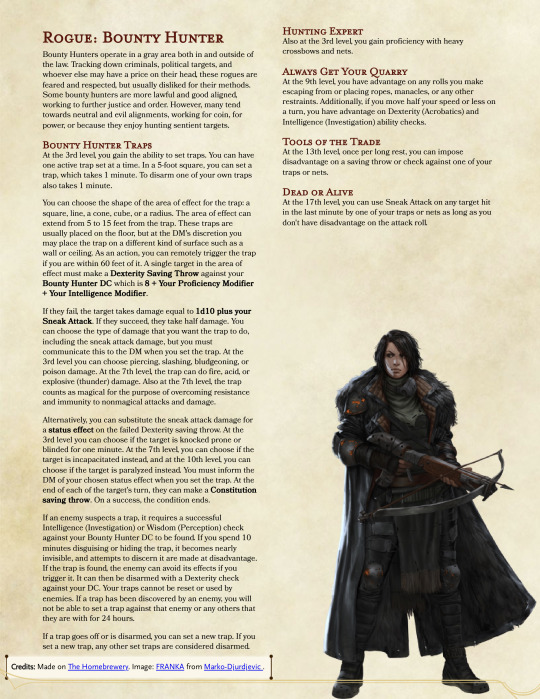
Rogue subclasses are pretty simple and fun to make. One thing that I like about rogues is that they can be very versatile and unique from one another. They are more specialists than anything, and they don't have to be thieves or criminals.
This subclass if for a bounty hunter like character archetype, and adds a new weapon/damage mechanic: traps, which can do a variety of damage as well as status effects once activated. Additionally, the bounty hunter gets proficiency with nets and heavy crossbows.
#d&d#d&d 5th edition#wotc#ttrpg#wizards of the coast#dungeons and dragons#dnd#dnd homebrew#homebrew#rogue#dnd rogue#rogue subclass#rogue dnd#homebrew rogue#roguish archetype
191 notes
·
View notes
Photo

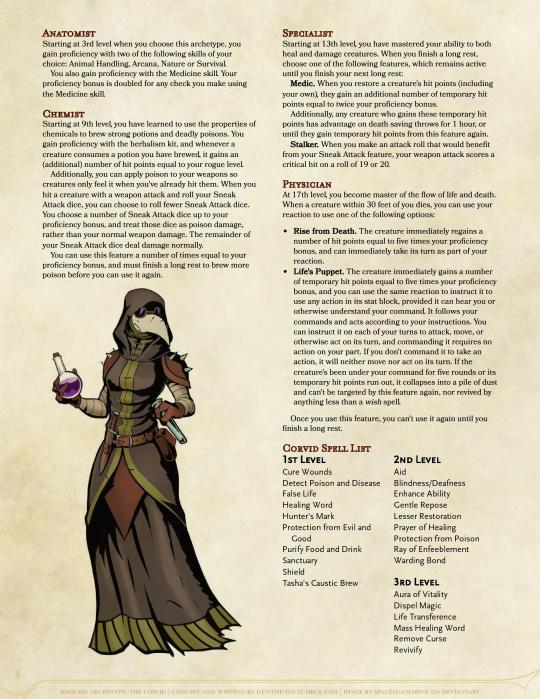
Subclass: The Corvid
Some - but not all - rogues are indeed the murderous, greedy creatures generaly stereotyping make them out to be. But some would rather align themselves with the ebb and flow of life, using their ability to form this energy to their will to heal others or do good. This means they are also able to hit where it hurts, however, making rogues that follow the way of the Corvid doubly dangerous... and doubly useful.
For better, full-page high quality imagery, take a look at the Corvid at the Homebrewery here!
#dnd#dnd5#d&d#d&d5e#dungeons and dragons#5th edition dungeons and dragons#roguish archetype#subclass#rogue#dev's homebrews#features#call this a quaternary spellcaster or something#its got less spells than an arcane trickster
304 notes
·
View notes
Text
That time I made rogue subclass.
0 notes
Text
Rogue: The Generalist (V0.2)
Alright, here's an updated version of the subclass. Thank you @homebrew-a-la-traumaverse for your feedback! I am also starting to reword somethings to fit typical subclass wordings, giving names for each feature, etc. I also have two potential revisions for the 17th level Magical Studies, with the other being at very bottom of the post, denoted by a *.
Flavor: It is to be expected for adventurers to learn and grow as they venture out into the world, but some rogues take this to the extreme. Generalist rogues are those who have dedicated themselves to learning various disciplines, though not necessarily mastering them. As such, they have learned to pick up on various skills through mere observation and putting them into practice with a combination of keen intuition and muscle memory.
There are various reasons a rogue would follow this path. They may be an exceptionally curious individual who wishes to learn all they can, not restricting themselves to a singular line of study. Or perhaps if they are a spy or charlatan, they follow this path in order to make their disguises even more convincing. After all, you can't make a convincing wizard if you are unable to cast even a single spell.
Quick Study (3rd Level): You gain a new action called Study. Using your action or bonus action while observing a creature use a skill or tool they are proficient in allows you to mimic said proficiency. An unwilling creature can make a Charisma (Deception) check against your Study DC (DC = 8 + proficiency bonus + Intelligence), with you failing to mimic the proficiency if they succeed. These mimicked proficiencies are imperfect, granting only half your proficiency bonus to checks made with said mimicked proficiency and cannot be increased by features such as Expertise. However, the bonus increases at certain levels, granting your proficiency bonus to mimicked proficiencies at 9th level and double your proficiency at 13th level.
You can have a number of these mimicked proficiencies equal to your amount of Sneak Attack die, with any new mimicked proficiency replacing one of your choice.
Keen Insight (3rd Level): You can use your Study action to instead observe a creature mannerisms, as long as you can see said creature. They make a Charisma (Deception) check against your Study DC. If they fail, you can automatically add your Sneak Attack to the next attack made against that creature without needing to meet Sneak Attack's usual requirements. You also gain the following benefits: you have advantage on Insight and Charisma checks made against this creature for the next minute and you learn if this creature has any resistances.
Preferred Subject (9th Level): You further your studies, either dipping into the study of magic or the use of martial weaponry. Choose one of the following:
Martial Studies: You gain proficiency in the Athletics skill, or double proficiency if you are already proficient. You can use your Study action to now mimic proficiency in a weapon or armor. Any melee weapon you mimic cannot have the two handed or heavy property and you can only mimic proficiency in medium armors or shields. Weapons you mimic proficiency in have the finesse property for you and any armor you mimic proficiency in do not cause you to roll at disadvantage for Stealth checks. You can have a number of martial proficiencies mimicked equal to half your Rogue level (rounded down).
Magical Studies: You gain proficiency in the Arcana skill, or double proficiency if you are already proficient. You can use your Study action to mimic the use of a spell. The spells you mimic are known to you and Intelligence is your spellcasting ability for these mimicked spells. You can mimic a total amount of spells equal to half your Rogue level (rounded down), where the base level of each spell counts towards this limit (ex. a 10th level Rogue can mimic one 3rd level spell and one 2nd level spell). Cantrips count as 1/2 a level. You also gain a pool of magical energy, known as Spell Points, that are used to cast these mimicked spells. The amount you have is equal to the amount of Sneak Attack die you have and they are regained on a long rest. The amount of points used to cast a spell determines the level of the spell cast, meaning you may up-cast a spell by using more points. Cantrips do not consume points.
Worldly Knowledge (13th Level): You have become exceptionally canny thanks to your travels. You gain proficiency in up to five of the following things: a language, a tool, or a skill.
You can also mimic how a language is spoken (if you hear it be spoken) and/or written (if you see it be written) if you observe a creature proficient in said language used in one of the previously stated ways for one minute. This proficiency is flimsy, only lasting for 10 minutes and only granting you the ability to get across basic concepts in the language.
Prying Eye (13th Level): You are able to deduce even more about someone through your observation. You gain additional benefits when using your Keen Insight feature: you learn if it has any immunities (damage or condition), the creature has disadvantage on attack rolls made against you until the end of your next turn, and you can confer the benefits of your study to another creature that can hear you immediately as a reaction.
True Polymath (17th Level): Your ability to learn has far exceeded expectations. You gain the other option you did not choose for your Preferred Subject feature and the one you did is enhanced in one of the following ways:
Martial Studies: You can now mimic proficiency in heavy and two handed melee weapons, as well as with heavy armors. You can also make a second attack when attacking with either a weapon you are normally proficient in or whos proficiency you mimicked.
Magical Studies: You can cast a spell you mimicked without using Spell Points once per day, for each of the spells you mimicked, as long as it is 5th level or lower. You also regain any expended spell points on a short rest.
*The other potential Magical Studies feature at 17th level would replace the free cast with: When you make a spell attack with a spell you mimicked, you can add half your Sneak Attack die (rounded down) to the damage of the spell, as if it was an attack made with a finesse or ranged weapon. This can be done as long as the attack follows the other requirements of the Sneak Attack feature.
Again, any feedback or suggestions are welcome! Thank you!
12 notes
·
View notes
Text
Third Casters: Revised | What if the spellcasting was better integrated into the classes
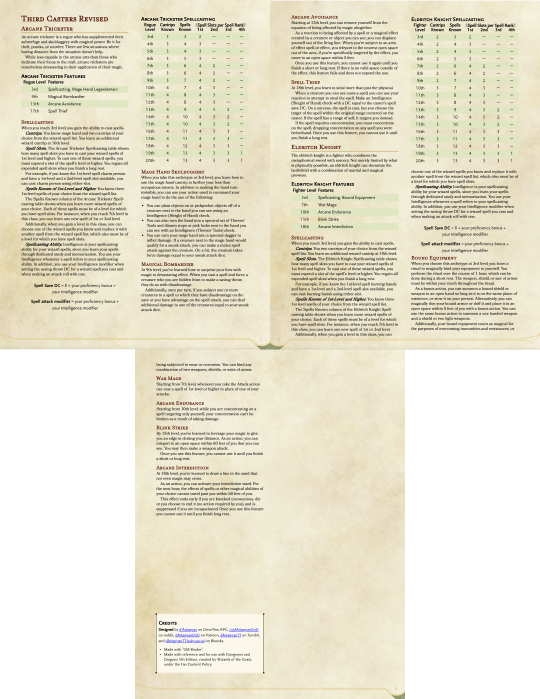
PDFs of this and more can be found over on at my Patreon here!
You should also follow my new Kickstarter so you can be alerted when it goes live next year!
My favourite subclasses, I must admit, are the two spellcasting subclasses in the Player's Handbook. I'm somewhat disappointed that they never did more of them. So, for totally no reason in particular, and totally not because I'm recreating D&D without wotc or hasbro's nonsense, I redesigned them.
Spellcasting
So, as a fun fact, did you know they removed mention of third casters in the OGL in the multiclassing section, but did not remove them in the roguish archetypes and martial archetypes section? They did change that in the Creative Commons version. I did have to redesignate the number of spells known from scratch though. It is now calculated as 1 + 1/3 level + 1/4 level, which is conveniently, very close to the original.
Mage Hand Skulduggery
Additional fun facts: every time a spell's name is printed in 5e, it is italicized. That includes within the name of the 'Mage Hand Legerdemain' feature. It turns out they didn't change this feature much from 3rd edition, I however decided to expand it slightly, in addition to adding the other primary feature of the rogue to it, (not just skills), but also making the fact that you're using magic and not your own dexterity a point. And, adding flavour to explain how you don't actually have to give thieves' tools to your mage hand.
Magical Bombardier
I always found it kind of disappointing you could never sneak attack with spells in 5e (at least until booming blade and green flame blade became a thing but those are their own bag of worms). Sure, there's a balancing point, but that's why I limit the basis on which you get it. Flanking is just not gonna cut it. Besides most of a rogue's damage comes from sneak attack anyway, their weapon is largely symbolic. I did sneak the other feature in here though.
Arcane Avoidance
I always liked the idea of evasion working by escaping the area altogether. So I did it here, but for single target spells too, because features. Woo!
Spell Thief
This is one of my favourite ideas conceptually. I love that the spell rogue can literally steal spells. But of course, I like the idea of you having to actually steal it, as opposed to making someone fight to keep it. But, you've got that Intelligence (Sleight of Hand) from earlier to use (and expertise) so you have good odds.
Bound Equipment
A really cool power from the eldritch knight, that I like to add to my martial casters in one form or another, I did have to recreate it from the base idea though, so I tossed my arcane aegis' ability in there too… I should redo that sometime.
War Mage
Those of you familiar with the eldritch knight and the bladesinger will note that this is closer to the bladesinger's extra attack than the eldritch knight's war magic… Well, I thought that since this the class that attacks a lot, having to choose is silly. You might also note that uses leveled spells instead of cantrips like the greater war magic feature, but much like how I designed the witch knight, your spells are limited, but your cantrips are not, additionally, your cantrips scale with character level, not effective caster level, so the cantrip version is more powerful, in my opinion
Arcane Endurance
This feature is wasted on the conjuration wizard. Useful, but wasted. You'd think the one that casts a concentration spell on itself that forces itself into melee would be a better candidate (transmutation). Now you can enlarge or haste yourself without fear that you're just gonna waste it.
Blink Strike
This is tangentially similar to the feature of this level in the official eldritch knight, but I like this more as an opener than 'oh, by the way.' It also doesn't require action surge (but you could still use it here) in part because I don't like it and totally not because I've redesigned the fighter to be without it all together.
Arcane Interdiction
Now, seeing as I'm doing this as an original work instead of a knock off of the original, I can't just greater war magic my way out of this one, especially since there's not an up. (I could do cantrips, but that feels a bit anticlimactic at level 18, even though they do 4 dice and would therefore give you like 6 attacks worth of damage). Besides, the fighter might not be a powerful spellcaster, it is a powerful character and magic user, so I decided "what's a powerful magical ability that feels like a commander type character would have?" and a magical line in the sand sounds fantastic.
And now to plug my stuff. I release homebrews weekly over on my Patreon.
Anyone who pledges $1 or more per post don't have to wait a month to see them, and also help fund my being alive habit.
At the moment, they have exclusive access to the following:
Undying Templates
Bone-Eaters
School of White Necromancy
Calls of the Grave
I also have three classes, and a splatbook over on DriveThrueRPG to check out:
The Rift Binder. A class specialising in summoning monsters and controlling the battlefield.
The Witch Knight. A class that combines swords and sorcery in the most literal way.
The Werebeast. A class that turns you into a half beast to destroy your foes.
d'Artagnan's Adventurer Almanac. A compendium of races, subclasses, feats, spells, monsters and more!
3 notes
·
View notes
Text
Emissary of Ravens
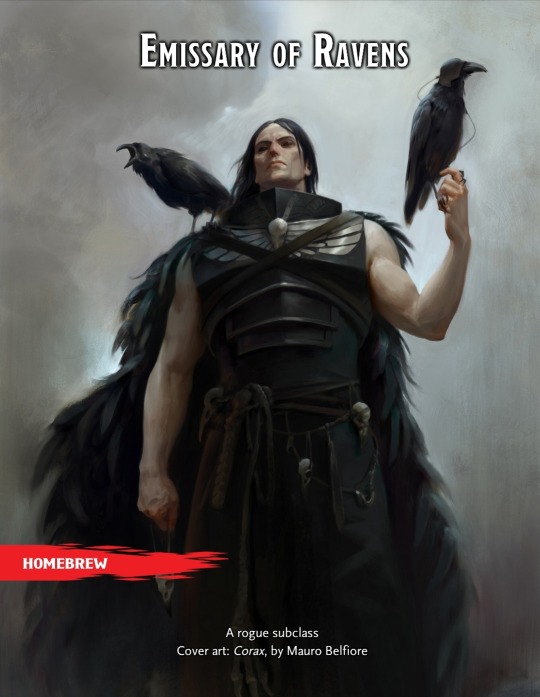

#emissary of ravens#crow#crows#raven#ravens#roguish#rouge#rogues#archetype#archetypes#familiars#dark#fav
3 notes
·
View notes
Note
it's been many years, rogue, and your blog is still my favorite on this entire website, if i had to rank them, for the sheer metric ton of shit that i've learned about from it and you and nowhere else. just wanted to give my periodic (biannual, possibly quinquennial) thanks for the sharing of your roguish expertise and radical passions.
Oh, thank you SO much. It's been a while, hasn't it? I'm terrible with compliments, and I never have the slightest idea what to do with them, but I really really appreciate it. It's incredibly satisfying to find that others get something out of this, and I'm really glad you like… whatever this is.
"Exploring the Rogue archetype in D&D, fiction, and real life", that's what it's always been. How strange that it's still here.
16 notes
·
View notes
Text
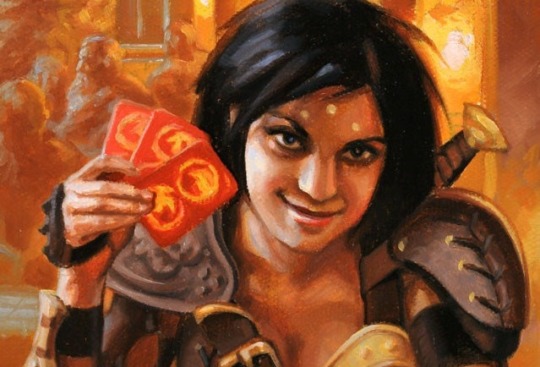
Masterposts
How to Rogue: a D&D 5e Masterpost
D&D 5e: Roguish Archetypes Masterpost Part I & Part II
Building a Rogue in 3.5 and Pathfinder: Collected Resources
Rogues in Fantasy Literature Masterpost
Dagger Fighting Masterpost
Thieves’ Cant Masterpost
Lock Picking Masterpost
Traps Masterpost
Tags and Credits
Basic Tags
How to Rogue: Exploring the Rogue class in D&D and assorted roleplaying games. Includes #fluff (roleplaying tips, character concepts, #backstories), #crunch (optimisation tips, guides, #magic items, #homebrew), and memes.
Rogues in Fiction: Exploring the Rogue archetype in literature, folklore, poetry, comics, games, etc, and #analysis thereof. Also relevant art.
Rogues in Theory: Exploring the Rogue archetype in history and society, and relevant subjects. Also #words of the trade (#etymology, synonyms, #thieves’ cant, linguistics).
Rogues in Practice: Tips on #how to stab and #how to steal (or, ahem, how to write/roleplay about stabbing and stealing), #exemplars of the trade (real life rogues and their exploits), and some less exemplary exploits. See also our esteemed colleagues in the #animal kingdom.
Art - Rogues Gallery: Rogue character portraits.
Art - Scene: Landscapes, fight scenes, #bar brawls, #heists, dungeon-crawling, etc. For urban landscapes, see #the city speaks.
Thieves’ Tools: Lockpicks! And assorted tools for breaking and entering where you’re not supposed to.
Tools of the Trade: Weapons! Mostly knives and daggers from all over the world (see the Dagger Fighting Masterpost for all the relevant tags), and some pretty swords and crossbows and the like.
Prison Ballads: The soundtrack.
…There is some overlap.
Quirky Thematic Tags
The ecstasy of gold: For loot, treasure, gold, and the deadly sin of greed.
The city speaks: For the hidden splendour of the city, from the gutters to the rooftops.
Heroes and villains: For good and evil and that grey waste in between which Rogues so often populate.
The phantom of liberty: For freedom, and storming the gates of heaven.
No tears for the creatures of the night: For the deadly sin of lust and its professionals.
The gambler’s face cracks into a grin: For gamblers and card cheats.
Dishonour on your cow: For honour among thieves, criminal codes, omertà, and blood feuds. File under the deadly sin of pride.
Fearlessly fleeing: For craven rogues and clever rogues. Wait, there’s a difference?
The ramblin’ rover: For vagrants and vagabonds and for the long-winding road.
The right to be lazy: For the deadly sin of sloth.
The hired man: For (mostly against tbh) the Rogue’s nemesis, the cop. See also #prison.
Swinging from the gallows tree: For the ignominious end that awaits us.
The quirk is strong with this one: See also #the potatoes of defiance, #big thief little thief, #the thrill of the heist, #the rich remember, #daring escape, #be the chaos you want to see in this world, #carnival, #stabbity, #only knives left, #dubito ergo sum, #fuck the king, #profanity makes everything better, #information wants to be free, #a begging I will go, #forbidden fruit, #the groaning rogue, #I fought the law, #the deserter. (#Tag namer explains some of the quirkiness.)
More Tags
Tabletop tales: It happened in somebody’s game.
D&D history: The conceptual and mechanical evolution of the Thief Rogue class in D&D, and other interesting stuff from the history of #roleplaying.
TRS: The Rogue speaks. Not to be confused with TSR.
Self explanatory: #D&D, #3.0, #3.5, #5e, #Pathfinder, #Pathfinder 2e, #AD&D, #roguish archetype, #feat, #skill trick, various #skills (#deception, #sleight of hand, #stealth, etc), #rogue fashion, #correspondence, #long post.
For anything else, try the search function and hope, but don’t get your hopes up because tumblr’s search function is appalling. Googling with the parametre site:theoutcastrogue.tumblr.com might actually be better.
Credits
All original work published here (i.e. the words and the occasional photograph of @theoutcastrogue aka @we-are-rogue, 2016–2023) is licenced under a Creative Commons Attribution-NonCommercial-ShareAlike 4.0 International Licence.
Avatar image: “Tymora’s Luck” (detail) by Ryan Pancost, from Dragon Magazine #388 | Wizards of the Coast 2010
Header image: “The Thief” (detail) by capprotti, for the game Exile Gods | Distant Orbit 2009
The WeAreAdventurers collective was started in 2016 by @wearepaladin.
See also the archival blog @wewererogue.

57 notes
·
View notes
Text
Prestige Class Spotlight 13: Aspis Agent
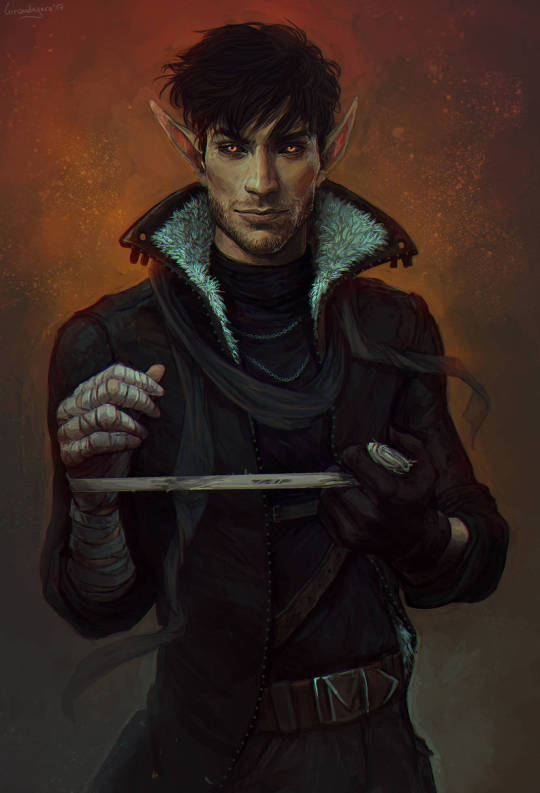
(art by LoranDeSore on DeviantArt)
Ah, the Aspis Consortium, an organization in the Lost Omens setting as insidious as they are greedy. With a mission statement that can be boiled down to “Make a Profit no Matter the Cost”, this organization is every bit of every bad thing about a worldview centered around money. Exploitation, theft, smuggling, slavery… If it can make them money, the Consortium will take advantage of it, all while maintaining the veil of goodwill through charitable works that are in the end infinitesimally tiny compared to the profit the organization makes exploiting the very people they’re supposedly caring for.
Remind you of anything in real life?
While the villainous and underhanded side of the Aspis Consortium can make them suitable antagonists for nearly any campaign, the most likely branch of the Consortium that members of the Pathfinder Society are likely to run into would be their agents. These explorers and plunderers seek out the same sort of ancient sites that the Society is interested in, but purely for the purpose of acquiring the relics within to either keep for personal power or sell to buyers without a thought or care about the impact they cause by doing so, be it disrupting sites held sacred by the locals or outright curses and magical traps on the relics they seek.
Which isn’t to say that the Aspis won’t have their field agents also participate in more domestic crimes as well, of course, but their training focuses on tomb robbing first and foremost.
Which is where this archetype comes into play. While primarily meant for villains, it can also be used for villainous protagonists in evil games, or even by former Aspis members who became (or are becoming), more heroic.
And outside the Lost Omens setting, this archetype could be quite useful for representing a character that is a professional temple delver, particularly one that often has to fight off other expeditions as well.
Delving into this training requires a whole suite of skills revolving around deceit and dungeon delving, as well as basic training with a whip and either keen senses honed around noticing traps or the ability to cast magic that reveals secret doors. The whip training in particular is due to the weapon being a signature combat style of the Aspis Consortium for it’s ability to cause nonlethal pain and control the battlefield.
True to their roguish talents, these agents learn the art of recognizing and avoiding traps if they don’t already have it, and improving upon their skills if they do.
Periodically as they grow in mastery, these agents pick up little tricks or improvements as they grow, drawing upon a short list.
Some stand fearlessly against larger beings and prove shockingly imposing against them, while others learn various advanced combat techniques ranging from setting up traps, using combat maneuvers, and even turning a whip into a deadly weapon. Others learn to ward their thoughts against intrusion so that foes only learn the thoughts they want them to know, while others with bardic training continue that to gain new and better performances. Some learn the art of concealing small objects and can even suppress their magic, which others still learn how to continue their bardic, inquisitor, or mesmerist training into spellcasting. Others learn techniques associated with rogues, while others learn enough magic to shrink an item down for easy carrying and concealment. Some who are also vigilantes can learn an additional technique for their social or vigilante identities.
They also learn how to conceal their aura so that magic that senses particular moralities fail to reveal anything. Later on, they can sense such attempts and even later provide a false aura in case their detection is sophisticated enough to sense all moral alignments.
Not content to merely bypass the traps they find, these tomb breakers learn how to rig both traps they’ve disabled or set up personally so that they can trigger them with a touch. After all, such ingenious mechanisms shouldn’t go to waste, whether they be used against rival delvers or particularly dull denizens. Later on, they can even trigger these traps from a distance with a deftly thrown rock or a nearly-invisible pullcord.
These agents also learn the art of striking for vulnerable points as a rogue would, or improving upon that skill.
Aspis agents know how to throw off the game of others, letting them demoralize or feint foes with clever words. Better yet, they can set such things up days in advance, calling back to a throwaway statement made days ago that sheds it in a new light and leaves a foe infuriated or reeling.
This prestige class certainly points the character in the direction of being the snarky rival archaeologist or treasure hunter, but the fact you can customize it to better suit several different base classes is a real boon. Not having true spellcasting increases is disappointing, forcing you to rely on the more roguish aspects of the class, and as such, your spellcasting choices will likely be built with that in mind, focusing more on buffs and utility than damage or debuffs. Still, this class can be a veritable bag of tricks, ranging from better casting to weaponizing and building portable traps, to performing all sorts of combat and utility tricks with a whip.
In the hands of an antagonist, this archetype can be quite effective for giving an adventure a villain or even recurring villain that isn’t inherent to the dungeon itself, which has the dual benefit of expanding the world and also give your villains and bosses somewhere to be that isn’t behind the final door. In the hands of a protagonist, however, it can a great way to have a morally dubious character in your game, or even a penitent one using their talents for good. Heck, aside from the lore there’s no reason this can’t be used with a swashbuckling hero that isn’t afraid to fight dirty to defeat evil.
Though most shabti, those beings created as surrogate souls to take the burden the souls of the wealthy after death, have a healthy respect for the dead and the world beyond due to how they are rescued form their fate by the psychopomps, not all feel this way. Some are bitter indeed for the cultures that invented the process of creating them to suffer in place of wicked rulers. Such is the case with Nayobi, who has become a professional tomb robber, not just for the riches therein, but to rob the dead she blames for her creation and suffering of their dignity.
For a month, the party has been racing against their rivals from tomb and ruin site trying to find the clues to the temple of the Horizon Eye, and they’ve both finally made it. However, the fight that erupts threatens to activate the Eye itself, a complex and powerful portal mechanism, and it’s guardian, a Lhaksharut inevitable!
The greedy often say that everyone has a price, that anyone will do anything if the reward is great enough. However, the counterargument is that there are lines that some people will not cross. Such was the case when the relic hunter Miriam Albrax learned what her employers planned to do with a dark relic she had procured, going into hiding as a hermit in one of the oldest forests in the world, watching over the relic with trap and forest ally alike.
#pathfinder#prestige class#aspis agent#shabti#lhaksharut#inevitable#Adventurer's Guide#Paths of Prestige
9 notes
·
View notes
Text
RPG Role Analysis Series #2 - Dragon Quest II
Dragon Quest II introduces a party of three, and the simplest way to describe them is one purely physical fighter, one strong mage, and a third somewhere in the middle. But, by looking at how magic was assigned to the Prince of Cannock and the Princess of Moonbrooke specifically, I think the members of this party are designed to have specific responsibilities to each other as a group, and it's not as simple as Moonbrooke being the party healer.
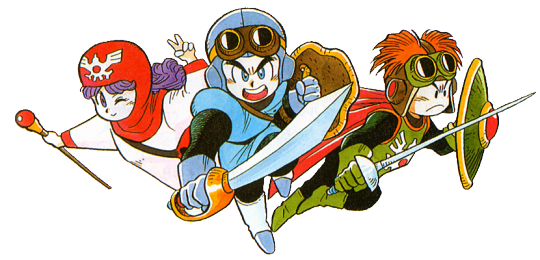
Prince of Midenhall - The strongest and sturdiest of all party members, but unable to cast any spells (barring magic items), the Prince of Midenhall is the most basic warrior type. Able to equip nearly all of the equipment (including exclusive rights to the strongest ones) in the game. Most reliable damage dealer, the other characters will be focused on giving him an opening to attack. Of note is that Midenhall has the Flee action instead of a Spells menu in combat, making him the only one that can pull his comrades out of a fight going badly. If the other party members are allowed to die, Midenhall might be the most likely to finish a fight on his own, but has to walk back out of the dungeon alone if he's missing a revival item, making him the rescuer of the party.
Prince of Cannock - An archetypical magic knight, extremely close to the DQ1 Hero, but with additional spells Squelch (single target poison antidote), Kabuff (mass defence buff), Thwack (low chance instakill), Kazing (revival spell), and Kamikazee (self-sacrifice to destroy all enemies), and lacking Snooze and Glow. Cannock is not as strong or hardy as Midenhall, and has less MP than Moonbrooke, emphasizing a jack of all trades style magic knight. In DQ1, the Hero's MP pool couldn't be compared to any other character, but having another mage on the party makes clear that, despite essentially being the same character transplanted here, Cannock's magic is meant to be mid-range.
Princess of Moonbrooke - The Princess starts at level 1 with Midheal and the largest MP pool, while also getting Squelch at level 2 (poison antidote) and multi-target healing midgame, which seems to set her up as the main party healer, though she notably lacks revival, which is uncommon in a white mage type. She also has Whoosh and Kaboom, powerful multi-target damaging spells, and Kasap (multi-target defense debuff), so fits as a red mage analogue. Offensively, Princess can only spend large amounts of MP to do multi-target damaging spells, but has a large MP pool to accommodate this. She also has Snooze (sleep spell), Dazzle (multi-target accuracy debuff), Holy Protection (repel), Evac (dungeon escape), Safe Passage (floor hazard null) and click (door unlocking), so her utility spells all in some way, including her battle crowd control spells tend to avoid or mitigate damage or enemy encounters/attacks. She also gets Hocus Pocus at high level, a random effect wild magic sort of spell. In addition to having somewhat higher agility than the other party members, she could be read as a bit roguish, being rewarded not just for healing, but for avoiding fights/damage by conserving healing MP for occasional large magical attacks, and punished for allowing the party to be knocked out, as she herself cannot revive them.
Things I find interesting about this party: Midenhall is the only party member who can escape a battle, either of the others can escape the dungeon, but only Cannock can cast Zoom to bring you all the way back to town. The game was really close to having you need all three alive to make the entire trip, but you can pull off a full escape with just Midenhall and Cannock. Midenhall and Moonbrooke would have to walk back to town from the dungeon. There isn't a clear cleric of white mage analogue in the Final Fantasy sense. Moonbrooke heals, but has enemy debuffs and can't recover her failure to keep HP up with a revive spell. Cannock can bring the others back and has defensive buffs, but misses the strongest heal spells. Combined, they have to keep each other alive to keep Midenhall alive to put through the most damage. I like also how Cannock can only reliably do single target offensive magic, and has to either roll the dice on an instant death spell, or sacrifice himself to hit more (really a panic button on the only character with reliable revival), and Moonbrooke can only reliably do multi-target spells at the risk of blowing through MP. Moonbrooke also lacks buffing or revival options, but can get those effects with a random chance through Hocus Pocus.
8 notes
·
View notes
Note
Do you mind if I ask your top 10 favorite characters (can be male or female) from all of the media that you loved (can be anime/manga, books, movies or tv series)? And why do you love them? Sorry if you've answered this question before.....Thanks...
Hello, and thank you for this ask!
It's really tough to pick just a few… I'll have to split this into two posts due to tumblr's word limit, but here are some that immediately come to mind. Remember, this list isn't exhaustive and isn't in any particular order. (Here's part two.)
(Warning: this list may include spoilers!)
Tyrion Lannister - His wit, intelligence, and resilience make him one of the most entertaining and tragic characters in ASOIAF. Despite being born into one of the wealthiest and most powerful families in Westeros, he faces discrimination and cruelty due to his dwarfism. He didn't inherit the beauty of his siblings, nor is he tall, handsome, or skilled with a sword, and he's not particularly well-liked by others. But Tyrion holds a pivotal role in the series for good reason, and it's rare to encounter such a masterfully crafted and captivating protagonist who also grapples with disability. As Varys once said, "ofttimes a very small man can cast a very large shadow."
Arya Stark - She stands as one of the most compelling and complex female characters in ASOIAF, yet she often remains underappreciated and misunderstood within fandom circles. While some may see her as a tomboyish archetype (forgetting that GRRM penned the books in the early 90's, a time when Arya's character was quite revolutionary in fiction), Arya's character transcends clichés to embody a raw and heartbreaking portrayal of a girl thrust into the brutality of war and forced to navigate a world torn apart by conflict as a child soldier. Separated from her family and faced with unimaginable challenges, Arya's unwavering determination to survive is both inspiring and heart-wrenching. What sets Arya apart is her multifaceted nature. She embodies a mix of magic, cunning, animalism, spirituality, and femininity, making her a rich and dynamic character. Her connection to her direwolf Nymeria and her training with the Faceless Men add layers of mystique to her narrative, while her unwavering sense of self and identity challenges traditional gender roles which modern readers can relate with.
Eugenides & Irene (because I can't mention one without the other) - In The Queen's Thief series, Eugenides, known as Gen, isn't just a master thief; beneath his sharp wit and roguish façade lies a man burdened by profound grief and the challenges of his disability. His journey through pain and loss adds intricate layers to his character, making him all the more compelling. As for Irene, the formidable queen of Attolia, her intelligence and resourcefulness are matched only by her inner turmoil. While she deftly navigates political challenges, the weight of her responsibilities and the harm inflicted upon her loved ones weigh heavily on her conscience. Their intertwined destinies and the magnetic pull between them form the heart of their portion of the series, making their romance a standout element of the story.
Ella of Frell - The curse placed upon Ella in Ella Enchanted, one of my cherished childhood books, serves as a powerful metaphor for the struggle many girls face in asserting their agency and setting boundaries. Forced to obey any command given to her, Ella's curse robs her of control over her own actions and decisions, leaving her vulnerable to manipulation and exploitation. Ella's struggle to assert her independence and reclaim her agency is a central theme of the novel, and it highlights the importance of standing up for oneself and setting boundaries. This aspect of her character resonates deeply with readers, particularly young girls, who may relate to the feeling of being powerless in certain situations.
Achilles - One of the most powerful moments in the Iliad is Achilles' encounter with Priam, Hector's grieving father. Priam's act of kissing Achilles' hands, despite them being responsible for Hector's death, demonstrates remarkable humility and shared grief. This profound display of empathy moves Achilles to return Hector's body to Priam. In this moment, Achilles transcends his own ego and recognizes the universal experience of loss and mourning. By agreeing to return Hector's body, Achilles symbolically abandons his pursuit of personal glory, finding redemption and closure.
8 notes
·
View notes
Text

Rogue subclasses are pretty simple and fun to make. One thing that I like about rogues is that they can be very versatile and unique from one another. They are more specialists than anything, and they don't have to be thieves or criminals.
This subclass is for an acrobat character, focusing on mobility, movement, jumping, climbing, and reducing damage.
#d&d#d&d 5th edition#wotc#ttrpg#wizards of the coast#dungeons and dragons#dnd#dnd homebrew#homebrew#rogue#dnd rogue#rogue subclass#rogue dnd#homebrew rogue#roguish archetype
127 notes
·
View notes
Text
Soul Weavers
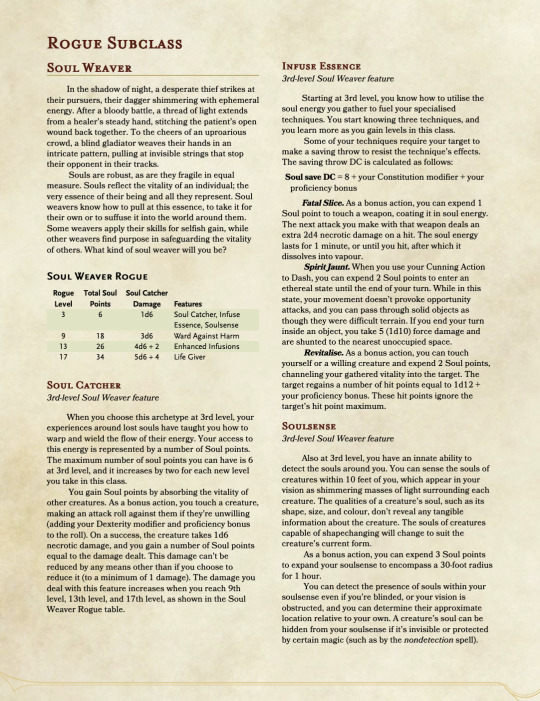

Its baby's first subclass!! 🤺
After Dinosaur Month, I felt like a change of pace was in order, so I decided to rework my very first homebrew subclass: The Soul Weaver! A roguish archetype perfect for those that enjoy managing an additional point system and making the agonising decision to either heal hit points or deal damage on their turn.
In Astera, souls are tangible (albeit usually invisible) entities that rise from a person after they've died. These little globules of energy are then picked up and ferried across the Ethereal Plains to live out eternity in one of the heavenly (or hellish) planes. But "what do souls look like?", I hear you ask; "what ferries them?", and "why do they need ferrying in the first place?". All good questions, though you'll have to wait a while for answers.
I'm excited to hear about what kinds of soul weavers y'all will play as :) I'm curious to hear your thoughts in how the subclass plays
28 notes
·
View notes
Text
Alright, I really want to add onto my Plundar has kleptomania thing because of a scene in Dungeon Party!, specifically after the Upply get the Skull of Hazza D'ur and take it to Vangelis.
Plundar is not a morally gray character. I've mentioned it before but if I had to assign him a D&D alignment I'd give him chaotic good. Throughout his appearances in the original 2011-2022 run of Ninjago, we're shown a few things.
Plundar steals on impulse. This is shown when we're first thoroughly introduced to him and the rest of the Upply in Dungeon Party!. Fungus introduces him then tells Plundar to give Cole his weapon back. Plundar's comment? "Sorry, force of habit." This implies that Plundar has stolen enough that he's made a habit of it, thus developing kleptomania which is an impulse control disorder. Him explaining himself with "force of habit" implies he struggles with impulse control.
When Vangelis asks "Do you all feel that way?" after Korgran says the Skull of Hazza D'ur is evil and must be destroyed, Plundar nods. It's like. Really subtle but still tells us a lot about Plundar, and tells us that he doesn't fit into a traditional roguish archetype (which generally involves some degree of gray morality; good examples include Robin Hood and Ronin). The thing that makes Plundar fit the rogue class of D&D is his kleptomania, and I doubt he necessarily thinks stealing is good. It doesn't bring him distress because he's not aggressively reprimanded for it by Korgran or Fungus; the most Fungus does is tell him to return Cole's weapon, and it's safe to assume he accepted Vangelis's quest for the purpose of looting the dungeons in Shintaro Mountain.
Plundar's a really interesting character to me. You do not get a lot of "this is right, this is wrong, and I will always do what's right" type rogues. Anything Plundar does that would be morally wrong is because of an impulse control issue that has probably festered over the course of years and he hasn't had help for, and that he feels remorse for acting on.
Anyway Ninjago does really well at subtle characterization, especially in the later seasons, and I absolutely love it and hope it continues into Dragons Rising.
23 notes
·
View notes
Text
Rogue: The Generalist (V 0.1)
Hello, this is my first homebrew post for D&D! To give an idea of what I'll be doing at this stage, for subclasses I will be posting about the general concept I want to follow with the concept and ideas for features. It is all very work in progress and any feedback would be greatly appreciated!
General Concept: For this subclass, I wanted to pursue the idea of a jack-of-all-trades sort of archetype, but separated from the inherent magic of the Bard. Rogue seemed like the best option, as it has the same skill monkey aspect the Bard shares. As for the overall fantasy and roleplaying aspect, this archetype is meant to encompass the kind of character that can learn exceptionally quickly and who have a strong urge to explore the world to learn even more.
3rd Level: You gain a new action called Study. Using this action while observing a creature use a skill or tool they are proficient in allows you to mimic said proficiency. An unwilling creature can make a Charisma (Deception) check against your Study DC (DC = 8 + proficiency bonus + Intelligence), with you failing to mimic the proficiency if they succeed. These mimicked proficiencies are imperfect, granting only half your proficiency bonus to checks made with said mimicked proficiency and cannot be increased by features such as Expertise. However, the bonus increases at certain levels, granting your proficiency bonus to mimicked proficiencies at 9th level and double your proficiency at 13th level. You can have a number of these mimicked proficiencies equal to your amount of Sneak Attack die, with any new mimicked proficiency replacing one of your choice.
3rd Level: You can use your Study action to instead observe a creature mannerisms, as long as you can see said creature. They make a Charisma (Deception) check against your Study DC. If they fail, you can automatically add your Sneak Attack to the next attack made against that creature without needing to meet Sneak Attack's usual requirements. You also gain the following benefits: you have advantage on Insight and Charisma checks made against this creature for the next minute, the creature has disadvantage on attacks against you until the end of your next turn, and you learn if this creature has any resistances.
9th Level: You further your studies, either dipping into the study of magic or the use of martial weaponry. Choose one of the following:
Martial Studies: You gain proficiency in the Athletics skill, or double proficiency if you are already proficient. You can use your Study action to now mimic proficiency in a weapon or armor. Any melee weapon you mimic cannot have the two handed or heavy property and you can only mimic proficiency in medium armors or shields. Weapons you mimic proficiency in have the finesse property for you and any armor you mimic proficiency in do not cause you to roll at disadvantage for Stealth checks. You can have a number of martial proficiencies mimicked equal to half your Rogue level (rounded down).
Magical Studies: You gain proficiency in the Arcana skill, or double proficiency if you are already proficient. You can use your Study action to mimic the use of a spell. The spells you mimic are known to you and Intelligence is your spellcasting ability for these mimicked spells. You can mimic a total amount of spells equal to half your Rogue level (rounded down), where the base level of each spell counts towards this limit (ex. a 10th level Rogue can mimic one 3rd level spell and one 2nd level spell). Cantrips count as 1/2 a level. You also gain a pool of magical energy, known as Spell Points, that are used to cast these mimicked spells. The amount you have is equal to the amount of Sneak Attack die you have and they are regained on a long rest. The amount of points used to cast a spell determines the level of the spell cast, meaning you may up-cast a spell by using more points. Cantrips do not consume points.
13th Level: You have become exceptionally canny thanks to your travels. You gain proficiency in up to five of the following things: a language, a tool, or a skill. You can also mimic how a language is spoken (if you hear it be spoken) and/or written (if you see it be written) if you observe a creature proficient in said language used in one of the previously stated ways for one minute. This proficiency is flimsy, only lasting for 10 minutes and only granting you the ability to get across basic concepts in the language. Additionally, your Study action can be used as a bonus action and grants additional benefits when used to observe a creatures mannerisms: you learn if it has any immunities (damage or condition) and you can confer the benefits of your study to another creature that can hear you immediately as a reaction.
17th Level: Your ability to learn has far exceeded expectations. You gain the other option you did not choose at 9th level and the one you did is enhanced in one of the following ways:
Martial Studies: You can now mimic proficiency in heavy and two handed melee weapons, as well as with heavy armors. You can also make a second attack when attacking with either a weapon you are normally proficient in or whos proficiency you mimicked.
Magical Studies: You can cast a spell you mimicked without using Spell Points once per day, for each of the spells you mimicked. You also regain any expended spell points on a short rest.
Again, feedback and criticism is welcome. This includes for stuff like wording or even suggestions for different features. Thank you!
9 notes
·
View notes
Text

Ruska:
The book is set in 1949, like the other characters he is imprisoned in a sharashka (basically still in the gulag system but they are given better conditions so they can work on engineering projects for the government, though it's still oppressive). He is 23. years old and spent the last few years living under false identities going on adventures trying to escape being caught, sort of roguish trickster archetype type, then once he's in prison he agrees to be an informer so he can act as a double agent to find other informers and manages to find a lot of them through the pay they are given, but he tells too many people and gets caught and shipped to a gulag.
Tundra:
His creator, Dr. Mikhail Cossack, is Russian, and I believe Tundra fits the category of "born in Russia but left" since he was created there. Tundra's fun because he decided "i don't want to just explore polar climates" and canonically redesigned himself so he could ice skate more gracefully.
10 notes
·
View notes